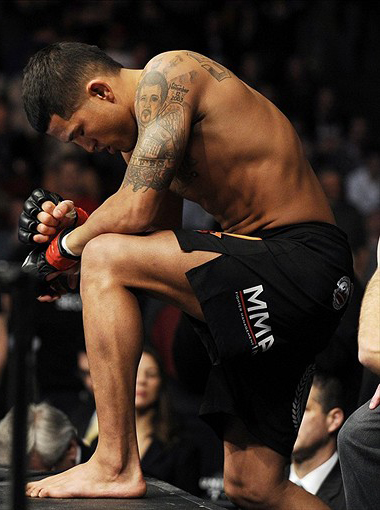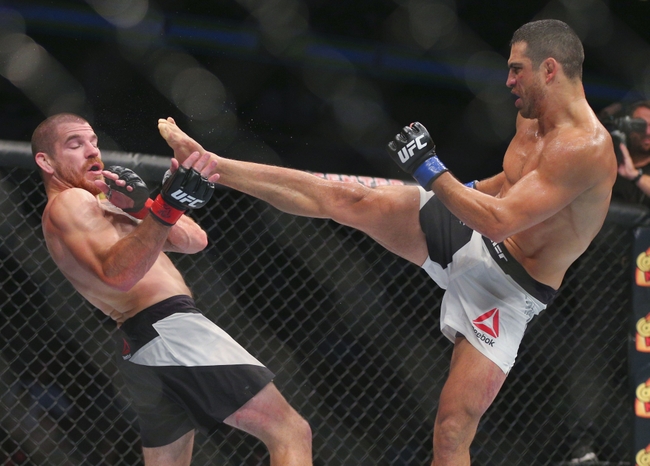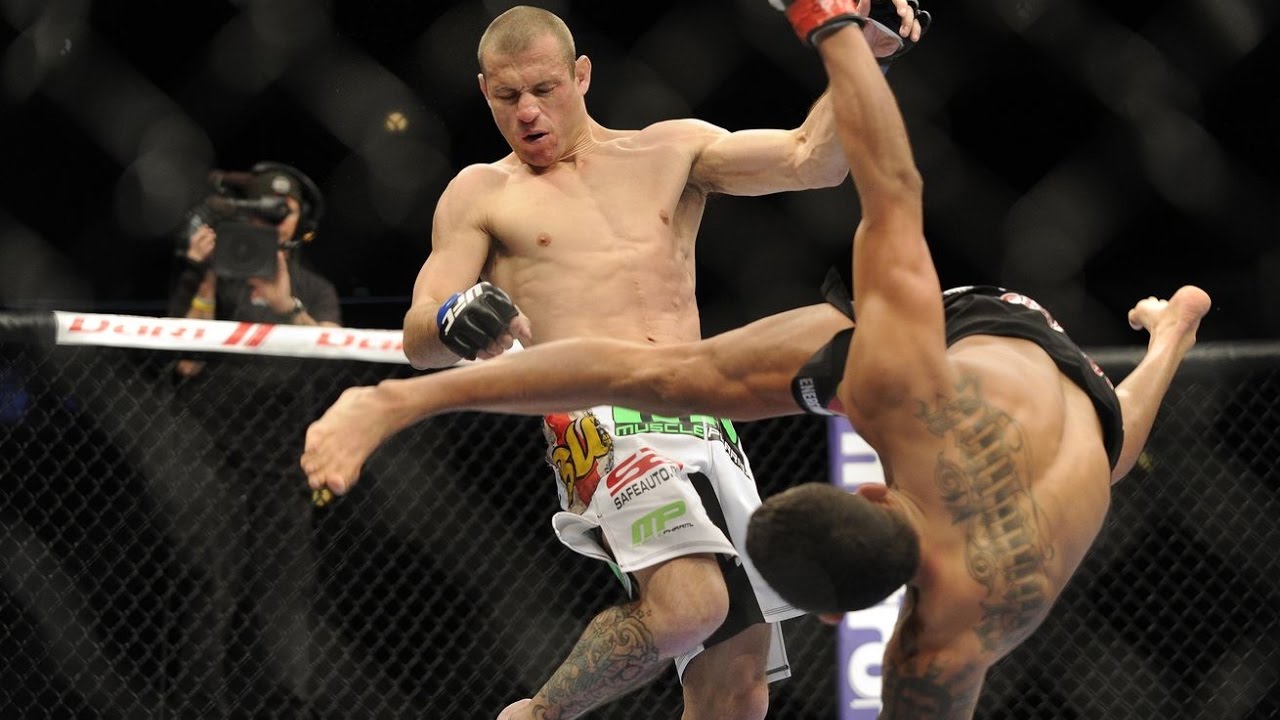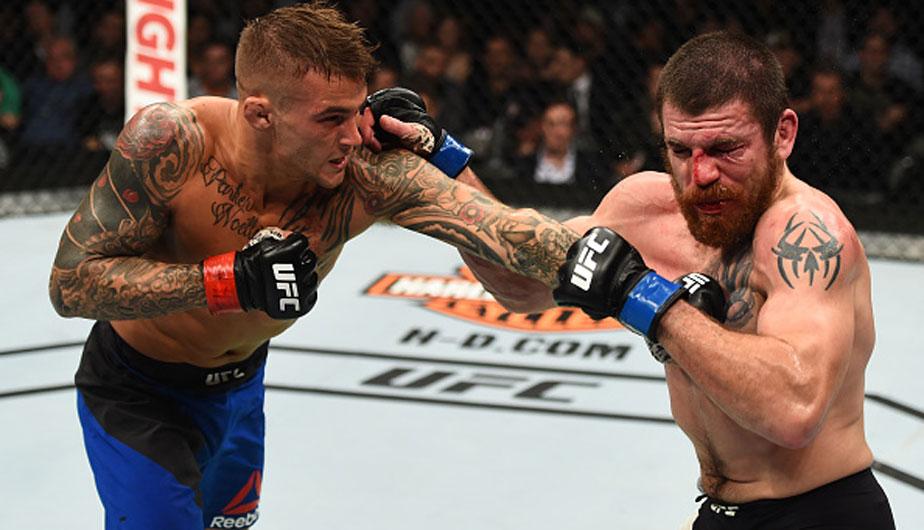This Saturday night at UFC 213, Anthony Pettis tries to get his career back on track when he enters the Octagon to face perennial lightweight contender and tough out Jim Miller. Today I am taking a look at the matchup and more importantly examining the things “Showtime” has lacked or not developed, which has led him to this crossroads fight against Miller. The former WEC champion, UFC champion, and pound-for-pound entrant, who peaked with a title defense over Gilbert Melendez at UFC 181,
has been on a three-fight losing streak at lightweight, and was .500 at featherweight, beating Charles Oliveira before missing weight and being summarily beaten up by current UFC Featherweight Champion Max “Blessed” Holloway. Today I provide and discuss ten talking points that explain why and how this fight was made, as well as offer a closer look at the flaws, mistakes, and missteps that have brought Pettis to this point in his career, and a better sense of who his opponent is and what he brings to the table:
10) Jim Miller is what they call in boxing circles a “journeyman.” Due to the abbreviated time mixed martial arts has existed, and the excessively sharp curve in technical, strategic growth, this sport hasn’t recognized or appreciated the role these guys play, largely in part due to the limited number of guys who can fill the role. Miller is a seasoned veteran who has faced every level, type, and age of opponent, sometimes winning, sometimes losing, but always learning and improving. Now at this stage of his career, clearly out of his prime and with thousands of miles on his odometer, Miller is depending exclusively on his awareness, cage IQ, and a career long refinement and diversification to keep him competitive and on the winning track.
9) Journeymen are known for two things: gauging talent and exposing talent. A journeyman has the savvy and the broad skillset to not be overwhelmed or outclassed in any one aspect of his or her sport, meaning if the fighter facing him/her hasn’t been developed properly, or isn’t a transcendent talent, then there is a better than average chance that fighter gets beaten. Don’t believe me? Refer back to Felice Herrig’s last three wins, all against young talented fighters, two of whom were undefeated: Kailin Curran, Alexa Grasso, and Justine Kish. All three are very talented (but not exceptionally talented) and unrefined fighters whose lack of layers and fine tuning led them to decisive losses.
8) Anthony Pettis is a talent — not a talented fighter or a fighter with talent — he is a true combat sports talent in regards to physical ability, creativity, offensive dynamism, and ability to execute. But in recent years he has suffered injuries, experienced long layoffs, taken repeated or extended beatings, and twice drained himself to make weight for a division he didn’t belong in. This has lessened his athleticism and his ability to turn fights around or stand up to the fusillade of abuse fighters with his talent often absorb when they lose a step. Anthony Pettis is no longer a transcendent talent, and he doesn’t have the technical refinement to successfully navigate that loss in athleticism.
7) All of Anthony Pettis’s advantages are attribute based. He (even at this stage) is bigger, longer, stronger, more explosive, quicker, and more flexible than his opponents, not to mention the fact he has historically been able to fight at a higher, harder pace than most fighters. If Miller had the exact same technical skills with even a hint of Pettis’s admittedly faded athleticism, this wouldn’t be competitive in any form or fashion. Even Pettis’s supposed advantage on the feet is in large part defined by and made effective by his physical ability, as well as the creativity and effectiveness that it allows him.
6) Jim Miller is the better mixed martial artist. He isn’t the more accomplished fighter; he hasn’t beaten the caliber of guy Anthony Pettis has. But he hasn’t had the safety net of Pettis’s durability and athleticism. Miller is the better wrestler — he has legitimate and well developed wrestling chops. He prefers singles/doubles and has shown an ability to create and win scrambles consistently. He has never been the sternest when it comes to takedown defense, but even as flawed as he has been in that area, he is still ten times better than “Showtime.”
On the ground, Miller isn’t just technical; he is deliberate, patient, and measured as a grappler, going for submissions in transitions, from top position, and from his back. Miller isn’t just a very skilled grappler, but one who has shown a great degree of awareness and timing. On the feet, Miller isn’t anything close to dynamic, creative, or devastating. His game, like his athleticism, is fairly meat and potatoes, but it is one defined by execution and precision. This is highlighted by Miller’s ability to effectively hold his own in exchanges, string together sharp combinations, and punctuate attacks with a punishing left kick to the body and legs. On top of that, Miller has routinely shown the ability to adjust in fight — which Pettis hasn’t done — and he has shown the ability to transition through all the ranges of mixed martial arts, something Pettis also hasn’t been able to do consistently.
5) Anthony Pettis is known as one of the best strikers in mixed martial arts, but Pettis is fundamentally flawed. Much like Holly Holm, the best part of his game is his kicks. He doesn’t put together crisp punching combinations, his shot selection is frustratingly inconsistent and limited, his footwork is one note when under duress, he is unable to use angles or pivots with any sort of regularity, and his defensive awareness and technical execution is so undeveloped that he can’t get away from determined opposition’s offense. And while individually his punches aren’t bad, his inability to put them together makes them less effective offensively and harder to use without becoming defensively irresponsible.
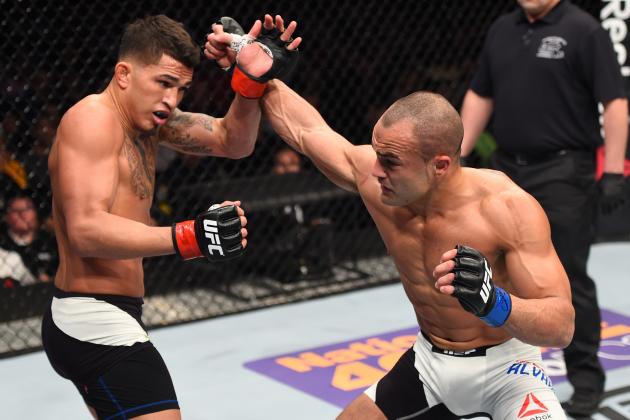 4) Pettis has no sense of urgency. As effective as he can be, a lot of his problems are a result of his unwillingness to push a pace when initiating offense, or raise his aggression when looking for counters. Pettis also doesn’t react with the correct amount of apprehension when an opponent builds offensive momentum. This is in large part due to his talent, his dependency on it, and how that dependency has shaped his approach to fighting. Pettis leans on his ability turn a fight around or end a fight regardless of how well thought out his opponent’s plan is or how sharp his ability to execute is. As Pettis said himself, “I just find these guys’ chins, I just find these submissions.” When you have made a career out of “finding” ways to win somehow, someway, then you never develop the proper amount of awareness, because you never had to figure it out, work it out, or set it up; you just did something and it always ended up being the right thing.
4) Pettis has no sense of urgency. As effective as he can be, a lot of his problems are a result of his unwillingness to push a pace when initiating offense, or raise his aggression when looking for counters. Pettis also doesn’t react with the correct amount of apprehension when an opponent builds offensive momentum. This is in large part due to his talent, his dependency on it, and how that dependency has shaped his approach to fighting. Pettis leans on his ability turn a fight around or end a fight regardless of how well thought out his opponent’s plan is or how sharp his ability to execute is. As Pettis said himself, “I just find these guys’ chins, I just find these submissions.” When you have made a career out of “finding” ways to win somehow, someway, then you never develop the proper amount of awareness, because you never had to figure it out, work it out, or set it up; you just did something and it always ended up being the right thing.
Examples of this would be the “Showtime Kick,” the lighting quick (and tight) first round armbar that finished Benson Henderson in their rematch, and the sudden guillotine that finished Melendez, who had essentially outsmarted and outworked Pettis until he was finished. On the opposite end we had a grindingly awkward decision loss to Clay Guida, which was echoed years later by an equally awkwardly grinding loss to Eddie Alvarez. Both losses came as a result of Pettis’s comfort and confidence that somehow, someway, he would turn it around.
3) Coaching is as big an issue as the fighter. It’s not that Duke Roufus is a bad coach — much like Mike Winkeljohn isn’t a bad coach — but the fact of the matter is that in both cases they developed fighters who had fundamental flaws in key areas. Much like Holm, Pettis has an attribute-based style that succeeded in spite of his technical skills and strategic awareness, instead of because of them. Now you have two fighters in Pettis and Holm trying to make adjustments technically and strategically to help revitalize their respective games, but neither has the direction or the fight IQ to properly apply these tools as part of a larger plan, and neither has actually addressed flaws in their games.
An example of this is Pettis, who has a terrible time backing into and getting stuck on the cage. He has increased his output and the selection of shots he uses to help limit the likelihood he gets stuck on the cage, but what he hasn’t done is learn how to pivot off the cage or get off the centerline to keep from being pushed back in the first place.
2) This fight is a chance for Jim Miller to get a big name win. Throughout his career, when he has faced a particular caliber of lightweight — let’s call them “elites” — Miller has lost…repeatedly. Dustin Poirier, Beneil Dariush, Gray Maynard, Nate Diaz, Donald Cerrone, Michael Chiesa, Diego Sanchez, Benson Henderson, Frankie Edgar; all these guys are TUF winners, former title challengers, or former champions, and Miller has lost to all of them. Every time Miller has stepped up, he has lost decisively, which is also part of the reason he has gotten to the stage of his career where he is considered a journeyman. UFC 213 offers him one more opportunity to get a “name” win on his resume, and hopefully stay in the discussion for potential title challengers.
1) This is a showcase fight for Pettis. Anthony Pettis is still a popular fighter, still marketable, and still has a pleasing style to fans; the UFC believes he can be some sort of star, and the promotion sorely needs them. As good as Miller is as an all-round fighter, as proven as he is against some of the better fighters in the world, he is still a journeyman and has yet to beat someone of Pettis’s caliber in regards to talent or accomplishment. This is the type of fight that he should win (in theory), and a caliber of opponent that allows the UFC to say Pettis is back.
Bonus: Sergio Pettis is the better striker and all-around fighter, technically, strategically, and philosophically. If Anthony had his brother’s temperament and approach, he would not be in the spot he is in right now.
At UFC 213, we either see Anthony Pettis take the first steps towards revitalizing his career and beginning the slow climb to title contention, or we see another step back in one of the all-time falls from grace seen in combat sports history. For Jim Miller, it’s business as usual — win or lose he takes another step toward cementing his reputation as one of the true professionals and toughest outs in mixed martial arts. Miller is a man who may never be truly elite in regard to personal accomplishment, but he will be remembered as a guy who was a mainstay in the best division in mixed martial arts, and helped shape the career arcs of some of the best lightweights in history. Whether Pettis gets added to that list remains to be seen.

UFC 213: Romero vs. Whittaker (formerly UFC 213: Nunes vs. Shevchenko) takes place July 8, 2017 at T-Mobile Arena in Las Vegas, Nevada.
Click the stars to rate how good you think UFC 213 will be.
**********

